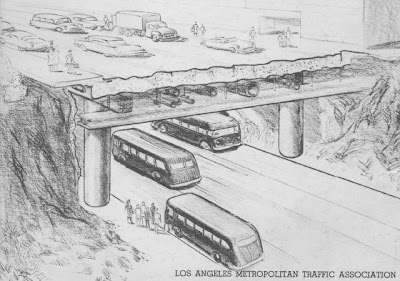
As we proposed in our inaugural welcome post, our goal is to provide context for current transportation issues as well as to share the rich resources in our collections. Our ability to digitize items and share them online provides access to rarely-seen documents and other assets of both historical and current value.
Los Angeles transportation history is full of wonderful projects, proposals, people and other stories. Many of them are familiar (as is the mythology surrounding them) while others are not well-known at all.
A few weeks ago, we celebrated the 50th anniversary of Freeway Flyer service and recounted the inauguration of bus service bringing suburban workers downtown, which continues to this day.
Prior to the 1960 Freeway Flyer rollout, The Los Angeles Metropolitan Traffic Association released the 1953 Express Busses On Freeways Transit Study.
The following year, the Association issued a supplemental study to address how buses on freeways would get downtown workers into the Central Business District since the freeways did not penetrate the area and riders would have to transfer to other transit options. The 1954 Supplemental Study Of Mass Transportation: Express Busses In Subways submitted on January 24, 1955 must go down as one of the more eye-opening proposals in Los Angeles' colorful transportation history.
Several interesting and prescient (as well as some downright stunning) recommendations came out of this suppplemental study. They include:
Street Arcades which contemplate set-back space to be taken out of frontage of buildings to make room for extra lanes on the street
Special Street Lane For Buses would set aside curb lane for use of buses and restrict certain streets exclusively to mass transportation
Intersection Separations provide for excavation and installation of escalators or ramps for pedestrians to cross below street surface, as well as escalators or ramps for crossing intersections above street surface
One-Way Street Proposals
Elevated Roadways in existing alleys for buses
Staggered Business Hours reinstating war-time requirements that not all businesses be open and closed at the same time, presumably mitigating traffic
Night Loading And Unloading of merchandise at street curbs during night hours
Fringe Parking lots serviced by shuttle buses or express buses on freeways operating downtown
Bus Subways providing "the most practical means of extending the freeway system through the Central Business District"
Yes, a "bus subway" was a serious proposal for carrying express buses from outlying freeways into downtown to avoid further contributing to congestion in the business district (recognized as the area bound by Figueroa Street, Sunset Boulevard, Los Angeles Street and Pico Boulevard). In fact, the proposal as submitted was regarded as "realizably cheap."
It recommended the "cut and cover" construction procedure as the most practical in the Central Business District, with work proceeding in "somewhat leisurely fashion with finish scheduled coincidentally with the Olympic Freeway south" of downtown.
Each of the proposals in this study are worthy of discussion, but it is the underground express bus network that really stands out, not only for its unique characteristics, but because it was featured on the front and back covers of the study. Those illustrations are featured here at the beginning and end of this post.
In the study's cover letter to the Board of Directors, the authors noted that "we herewith submit further studies -- limited, of course, because of lack of funds, staff, and time -- of the mass transportation problem in the Central Business District developed along such phases as seem essential now."
Their lack of funds, staff, and time should certainly not be regarded as any hindrance to their creativity.
Tomorrow, a thought-provoking look at the maps depicting where exactly this underground bus network would be located.

.jpg)